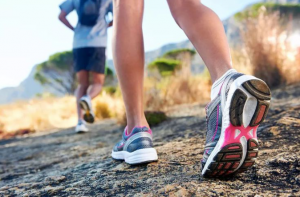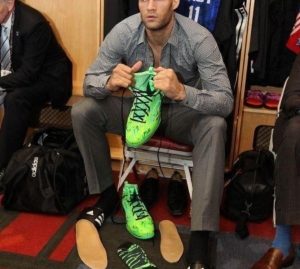Jogging is the easiest aerobic exercise to improve “cardiopulmonary function”, with the least muscle involvement and the lowest technique. However, if the core, hip, and leg muscles are not strong enough before running, the point of exertion and the wrong position of the soles of the feet during running may cause you to run short, not far away, or even get injured easily.
How can running so that it won’t become “middle-aged with injured knee”? Should I run with the forefoot or the heel first? Should I take big steps or small steps when running? The sound of running is banging, which means that the running posture is incorrect? First, understand the following 5 concepts.
Concept 1/Dodon’t run away! Strengthen muscles to prevent injuries
To run far, long, and not hurt, it is very important to strengthen the muscles of the body before running.
Knee joints and ankle joints have to bear three times the weight of the body for each step. Many people have only started running for two or three months, and the knee joints are painful. Most of the lower limb muscles are not strong enough or they can bear it in a short time. Excessive running volume, caused by excessive fatigue.
Before running, you must first exercise the most basic “core muscles” needed to cope with life, as well as the hip, thigh, and calf muscles that you need to use when running.
Only when these muscle groups are strengthened can the body’s center of gravity and running posture be maintained correctly when running, and the body will not overload other muscles in a compensatory way. It can also maintain the joints in the right posture and be less likely to be injured.
(It is important to run long, and not hurt. It is very important to strengthen the “core muscles” before running.)

Concept 2 / The posture must be correct when running!
Running is an extension of walking. The correct way of running should be to maintain an upright posture for the upper body, not to lean forward or backward to avoid the deviation of the body’s center of gravity, which will cause the burden on the back muscles and the impact of the ankle and knee joints.
When running, keep your upper body straight and relax your shoulders and neck as much as possible. Bend your elbows to 90 degrees, hold your empty fists in front of your chest, and swing back and forth with your feet. In addition to balancing your body, you can also train your shoulders and waist muscles.
When running, the heel of the foot that touches the ground touches the ground first, and then quickly shifts to the foot to point and push backward. The force moves up the calf, thigh to the waist from the sole, and drives the swinging foot.
The force of the swinging foot forward is centered on the hip joint of the waist, driving the thighs and calves, and after the soles of the feet touch the ground, the weight of the body is transferred forward, and the swinging feet become the grounding feet. When the center of gravity shifts to the forefoot, And then push backward, and repeat this process to complete a smooth running movement.
Note that you must relax your waist, knees, and ankles when running, and your knees should be slightly bent when you touch the ground to avoid being overly stiff and directly bearing the impact of running on your body.
(The correct way to run should be to maintain an upright upper body position, relax the shoulders and necks as much as possible, bend the elbows to 90 degrees, hold the empty fists in both hands and place them on the chest, swing back and forth with the feet.)

Concept 3: Whether the back heel or the forefoot touches the ground depends on the running speed
When the hips start to drive the big and calf legs to run forward, the moment the front footfalls, whether the heel should land or the sole should land is a problem that plagues many people.
“Whether the heel touches the ground first or the forefoot touches the ground first when running depends on the speed of the center of gravity displacement during running.”
When jogging, the body’s center of gravity shifts slowly and needs to be supported for a long time. Therefore, it will first touch the ground with the heel, and about 20-30% of the center of gravity will quickly transfer to the foot. Finally, the toe pushes off the ground and exchanges the feet.
The faster the displacement speed of the center of gravity, the more forward the proportion of the soles of the feet on the ground, even at the fastest speed, only use the toes on the ground, exert the strength of the ankle joint push and push so that the body displacement speed reaches the best state.
For a good runner, the specific gravity and stride length when the soles of the feet are on the ground can be used flexibly. For slow-running jogging that lasts longer, it is recommended that the soles of the feet follow the ground (20-30%) and quickly move to the toe push, and then run for longer distances repeatedly. When it is necessary to accelerate the crossing or the final sprint, change the specific gravity position of the sole to generate a faster speed and strive for the best chance.
Concept 4/Should you take a big step or a small step when running, varies from person to person
In addition to the correct proportion of the center of gravity of the soles of the feet when running, it is necessary to save effort, run longer and farther, and the stride size when striding is also a major point.
The size of the stride depends on the force of the landing foot. The greater the force of the push, the greater the displacement of the body’s center of gravity, the greater the step is required to swing the foot to maintain the center of gravity and reduce the impact force, so the stride will also be Bigger.
Too much stride will not save effort, because when the center of gravity shifts, it takes more effort to move the foot forward; in addition, too large a stride will cause the center of gravity of the body to form an oblique angle with the foot on the ground, causing braking. The force that hinders the forward transfer of the body’s center of gravity not only slows the forward transfer speed of the body but also impacts the knees and spine, which can easily cause sports injuries.
If the stride is too small, it will not be able to give full play to the strength of the foot on the ground, waste physical energy, and cannot produce the maximum benefit of the foot on the ground to move the body forward.
If you want to know if you take too many steps or too small steps when you are running, you can make a video yourself. Ask the coach to observe and see where your body’s center of gravity is every time you push forward with one foot. The stride is still too small, and then gradually correct it.
(The size of the stride when running depends on the strength of the foot on the ground. Too large a stride will hinder the force of the forward transfer of the body’s center of gravity, not only slowing the forward transfer speed of the body but also more likely to cause sports injuries.)

Concept 5/The sound of running is banging, which means that the running posture is incorrect?
Understand the running posture, I believe that many runners will hear other runners from time to time during the running, and pounding footsteps come from afar.
There should be no loud noises when running. “Too loud running sounds means that the body’s “muscle strength is insufficient” or “the center of gravity is over-leaning forward and the center of gravity is loaded on the soles of the feet.”
When the body’s muscle strength is not enough to support the weight of the whole body when running, the running sound will be loud every time the bodyweight is completely pressed on the soles of the feet. In addition, when the center of gravity of the body leans forward, the weight of the whole body will be driven by the center of gravity, and the whole body will be released to the soles of the feet, and the sound of touching the ground will be loud.
Therefore, before running, you must exercise the strength of your whole body muscles. When running, the upper body should be kept vertical and the center of gravity should not be tilted forward. The running sound is not too loud to save effort.
Although running is very simple, it is easy to get injured when running wrong. Only by understanding the above 5 concepts before running can you enjoy the benefits that each step brings to your body.
Hot blogs:
The Easiest Custom Insoles: Heat Moldable Insoles
Custom insoles, also known as orthotic insoles, are designed to provide personalized support and comfort for individuals with various foot conditions. In [...]
Children’s Insole Size Conversion Chart
The standard sizes for shoe insoles may vary from country to country, making it a headache to choose the right insole for [...]
Do custom orthotics need to be made by a doctor personally?
Custom orthotics do not necessarily need to be made by a doctor personally. While doctors, specifically podiatrists or orthopedic specialists, are often [...]
Do NBA players use custom insoles?
Custom insoles are not only helpful for people with foot health issues, but they also play a significant role in targeting the [...]
